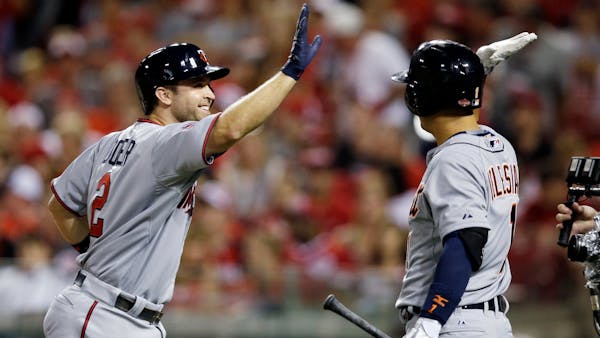CINCINNATI – By all accounts, Major League Baseball's guidelines to improve the pace of play are working. According to league statistics, the average time of a game is 2 hours, 53 minutes and 4 seconds — a decrease of 9 minutes, 17 seconds from last year.
"If we hold it, that will be the largest decrease since 1965 and that's another reason to be encouraged," MLB Commissioner Rob Manfred said Tuesday in his annual All-Star meeting with the media.
Players association head Tony Clark expressed similar sentiments about the guidelines to speed up the game. But the two might be butting heads soon if MLB approaches them with its next idea to quicken play.
MLB wishes to add a pitch clock to games. It experimented with one during Arizona Fall League play last year and is trying it out in Double-A and Triple-A this season. Manfred sounded as if implementing the pitch clock in the major leagues is a logical next step.
"We are really encouraged by the results of that experiment in terms of how it moves the game along," Manfred said. "It will be a product of conversations with the MLBPA. We remain positive about the 20-second clock as something that could be useful to the game at the big-league level."
Clark praised his association for making adjustments to the guidelines presented by the league for this season. He pointed out how it can be tough for some players to change habits. But his concern for adding a pitch clock was clear.
"When you add the third deck in the major leagues, when you add all of the other moving pieces tied to the major league game, the idea that a particular rule in Double-A or Triple-A or Single-A or the fall league — because of how it may have been worked into the system there means that it would automatically work in the big leagues — is not true," Clark said. "The game is fundamentally different. The game is fundamentally faster. There are more considerations that have to be made on the major-league level than the Single-A level, Double-A level or the Triple-A level."
So far, so good for the current pace of play measures. A batter has to keep one foot in the batter's box at all times. Managers must remain in the dugout during replay challenges. Innings must start promptly after commercial breaks. And pitching changes have to take place in a timely manner.
After threatening to fine players for violations after a month grace period, the league backed down. And umpires have allowed wiggle room for batters who have stepped out of the box.
"When you talk about pace of play, if anyone is going overboard, like a hitter walking too far away or a pitcher taking a long lap around the mound, those things can be avoided," Oakland catcher Stephen Vogt said. "If the batter is in the box before the pitcher is on the rubber, you can step out. As long as the pitcher is ready to go and the hitter is ready to go in a reasonable amount of time, I think it's great."
One thing working against MLB's initiative to shorten games is the use of instant replay. Manfred pointed out Tuesday that replay was expanded this season to include plays when baserunners are tagging up from bases. He said technological gains have enabled them to perfect the split-screen shot of the runner leaving the bag with the fielder catching the ball. He predicted expansion will continue as technology improves.
"The two things go in opposite directions, instant replay and the pace of game. No doubt about it," Manfred said. "But the trick is good technology and good training to keep the reviews as short as possible."
The average Twins game has dropped dramatically, from 3:03:01 last season to 2:49:49 this season, but that might be a product of improved Minnesota pitching more than anything.
Anze Kopitar scores in overtime, Kings beat Oilers 5-4 in Game 2 to tie series
Thunder's Holmgren bests Pelicans' Valanciunas in center matchup to help OKC take 2-0 lead
AP PHOTOS: Russian kids ride sticks with a horse's head in hobby horsing competition
Defending champion Golden Knights beat Stars 3-1 to take 2-0 series lead home to Vegas

